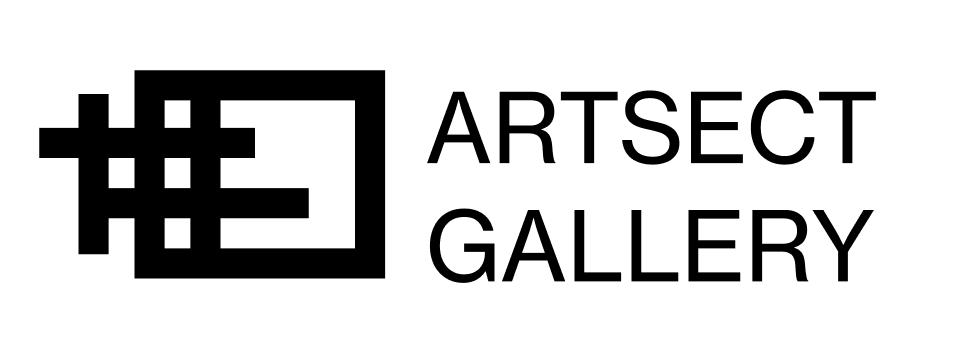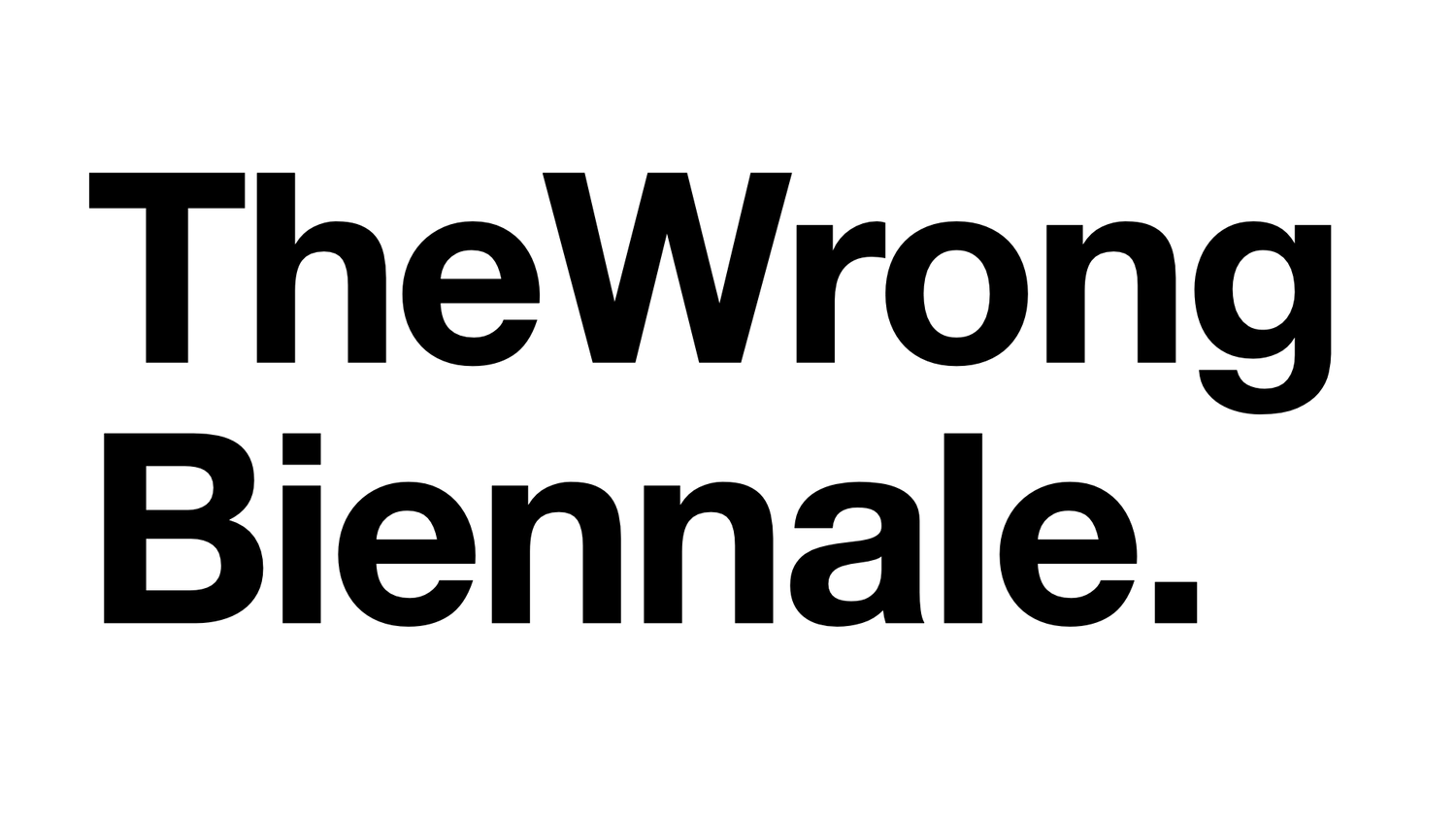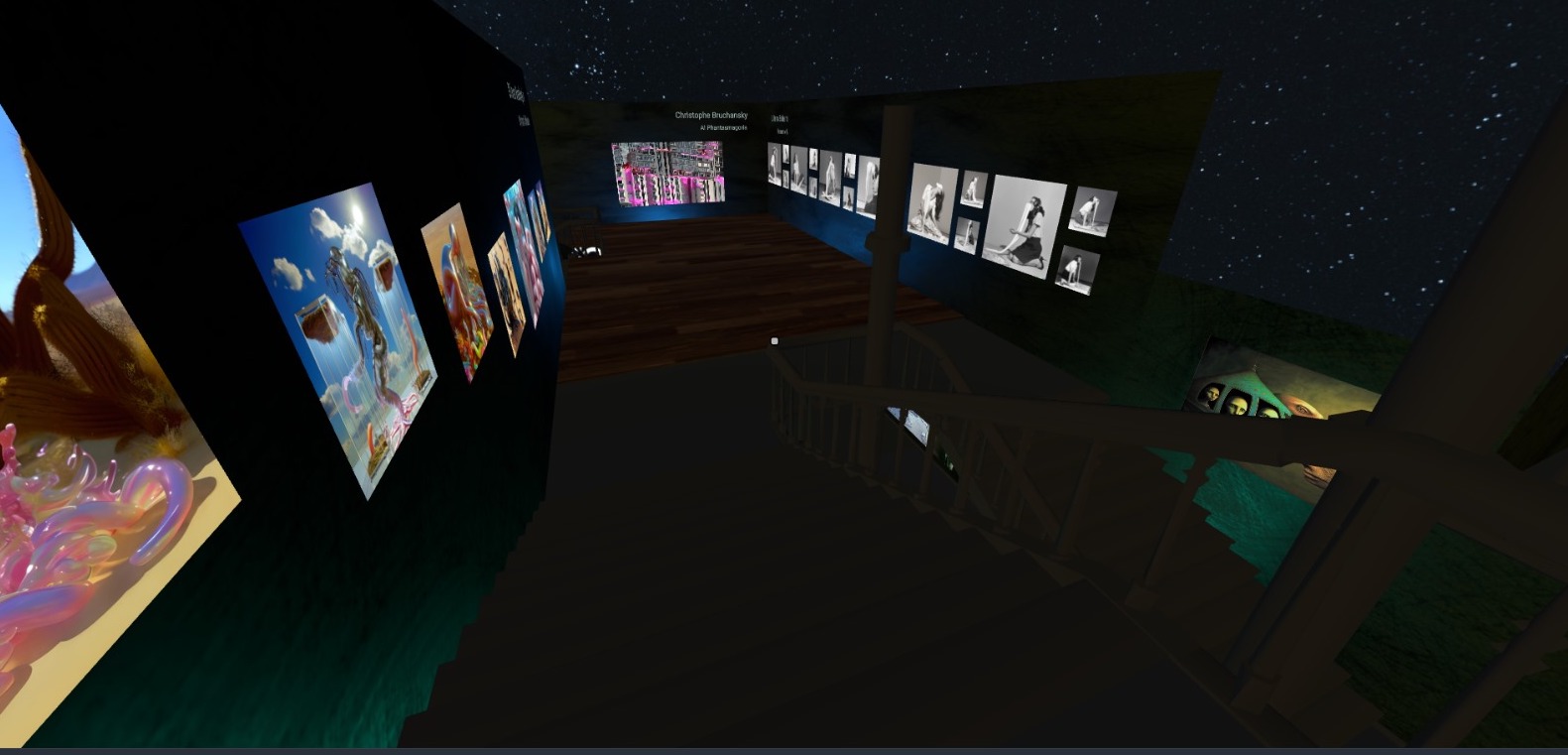An Official Pavilion of The Wrong Biennale 2023/24.
Our VR venue will be open from November 1st 2023 to March 1st 2023, and can be experienced on your web browser or at our physical venues!
https://instagram.com/_becoming_machine_
Physical Exhibition in London
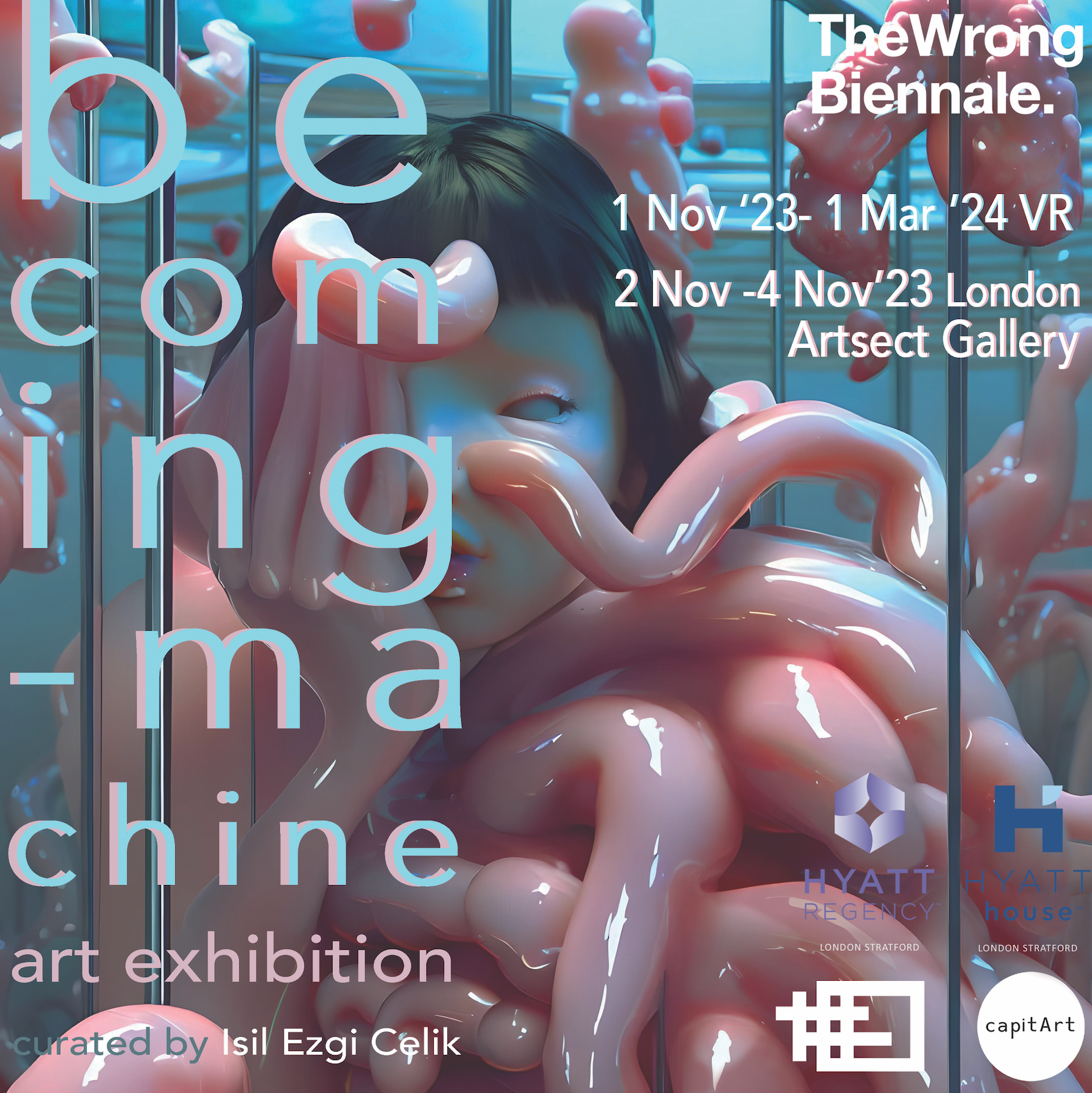
Book: https://www.eventbrite.co.uk/e/the-wrong-biennale-in-hackney-wick-becoming-machine-exhibition-events-registration-733749453367?aff=oddtdtcreator
Event Program in London
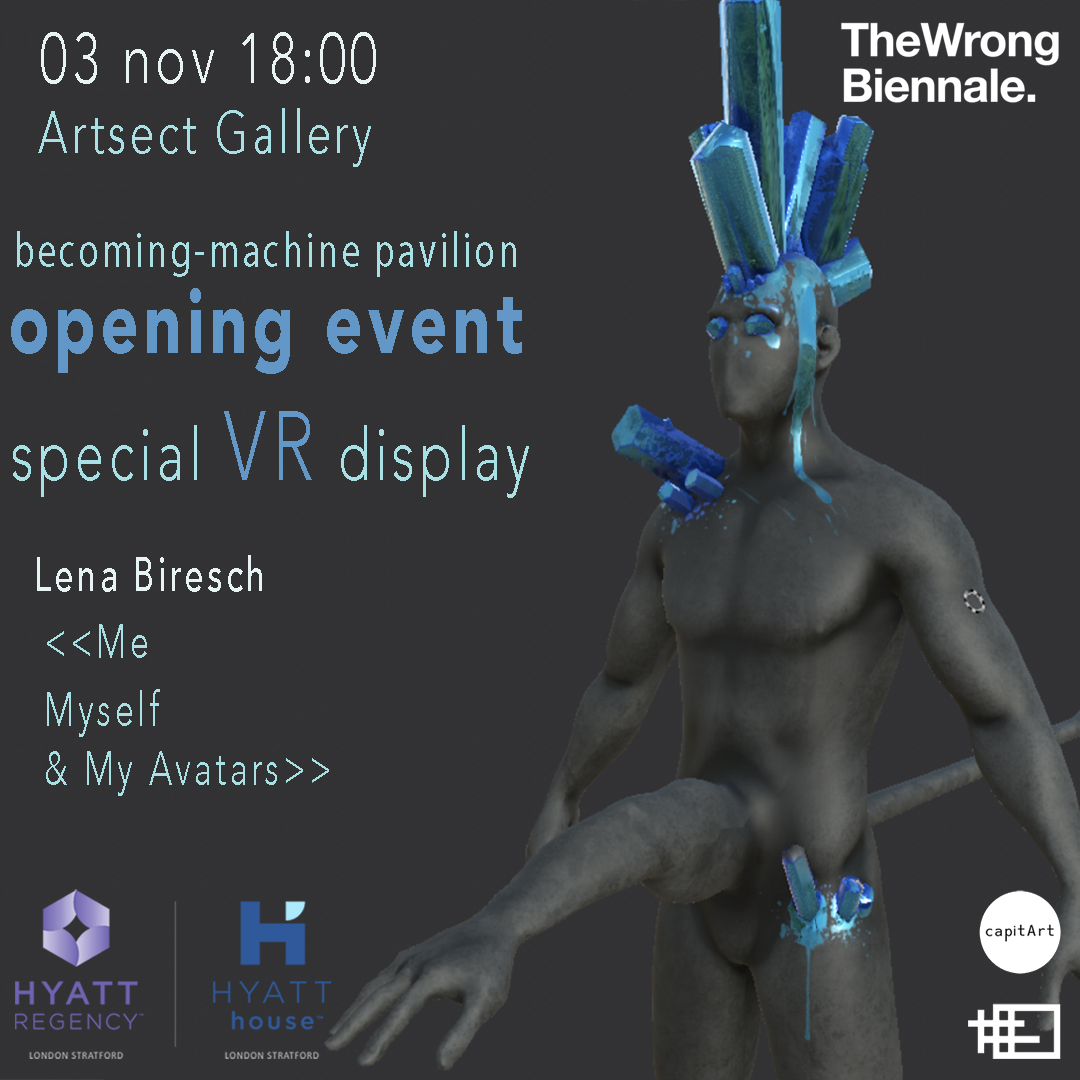
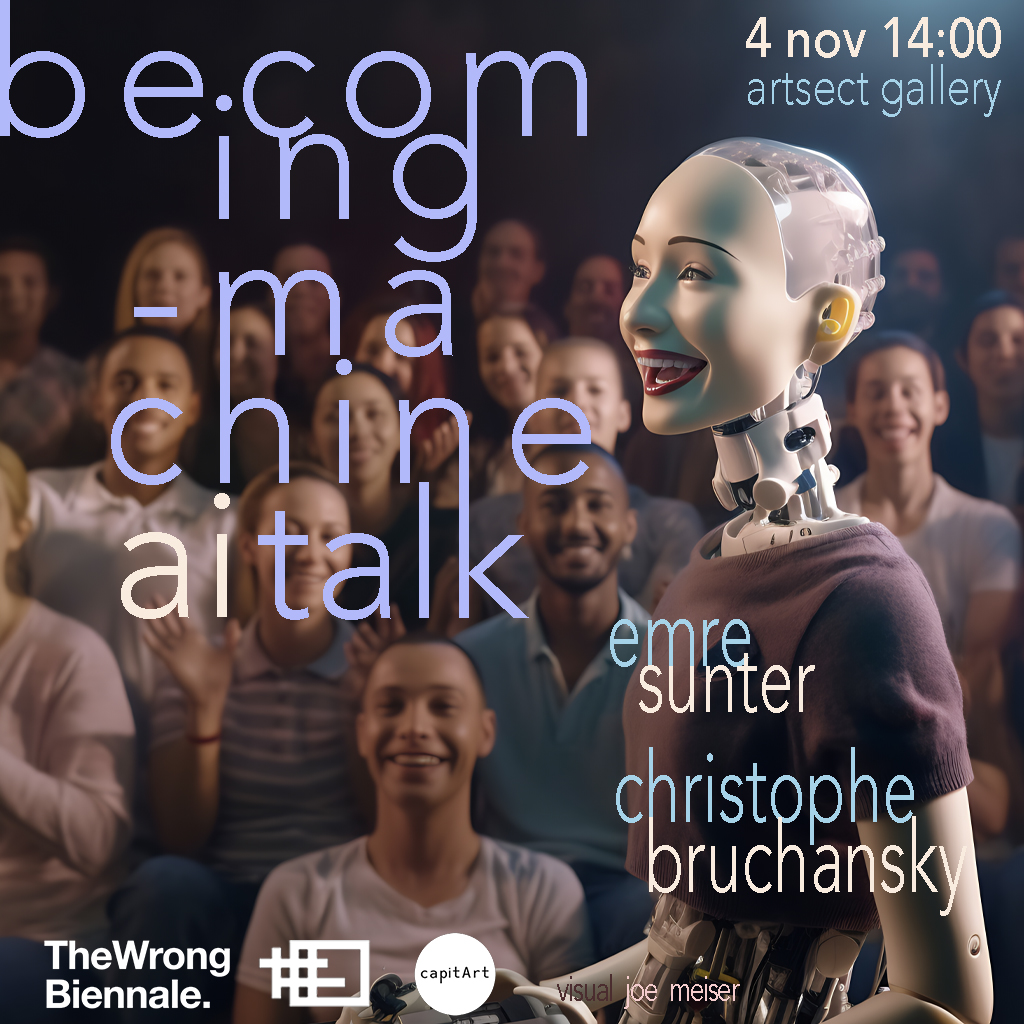
Curated by Isil Ezgi Celik, The exhibition Becoming-Machine is a VR & physical exhibition in London at Artsect DAO Gallery (https://www.artsect.xyz/), inviting visitors to explore the concept of becoming-machine through the lens of AI-generated and AI-assisted artworks. Drawing inspiration from Gilles Deleuze’s philosophy, the exhibition will showcase the dynamic relationship between human creativity and machine intelligence, blurring the boundaries between the human and the machine.
Participating artists: Stephen Roddy – Seph li – PolakVanBekkum – Martina Menegon – Maciej Szczygielski – Liliana Zaharia – Lena Biresch – Joe Meiser – Jiayu Liu – Jiayuan Yu – Hana Yoo – Karlos Gil – Frida Braide – Deirdre Barrett – Dilara Başköylü – James Bloom – Christophe Bruchansky – Amos I. – Allie Dechow – Ali Nâzım Beşikçi
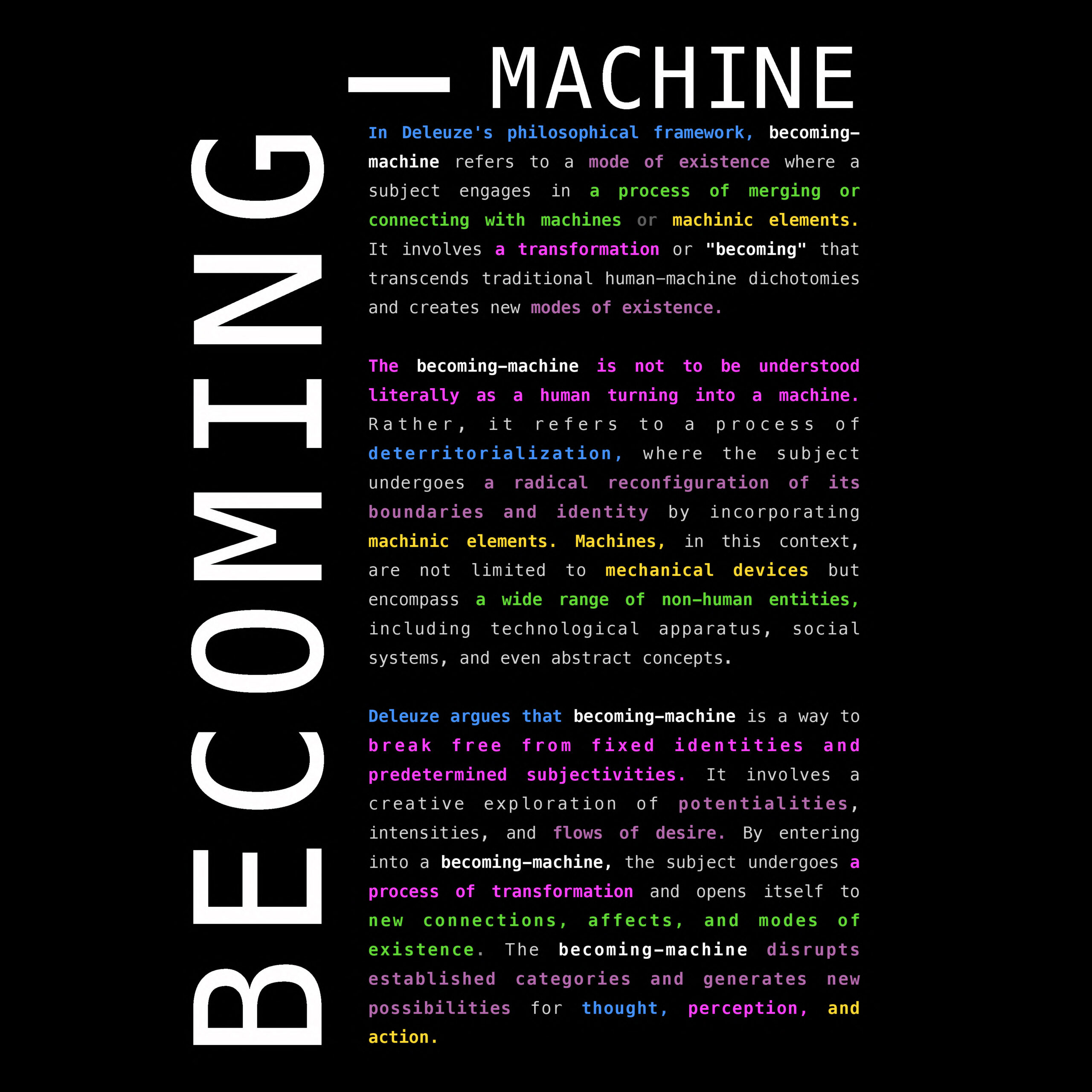
ARTWORKS
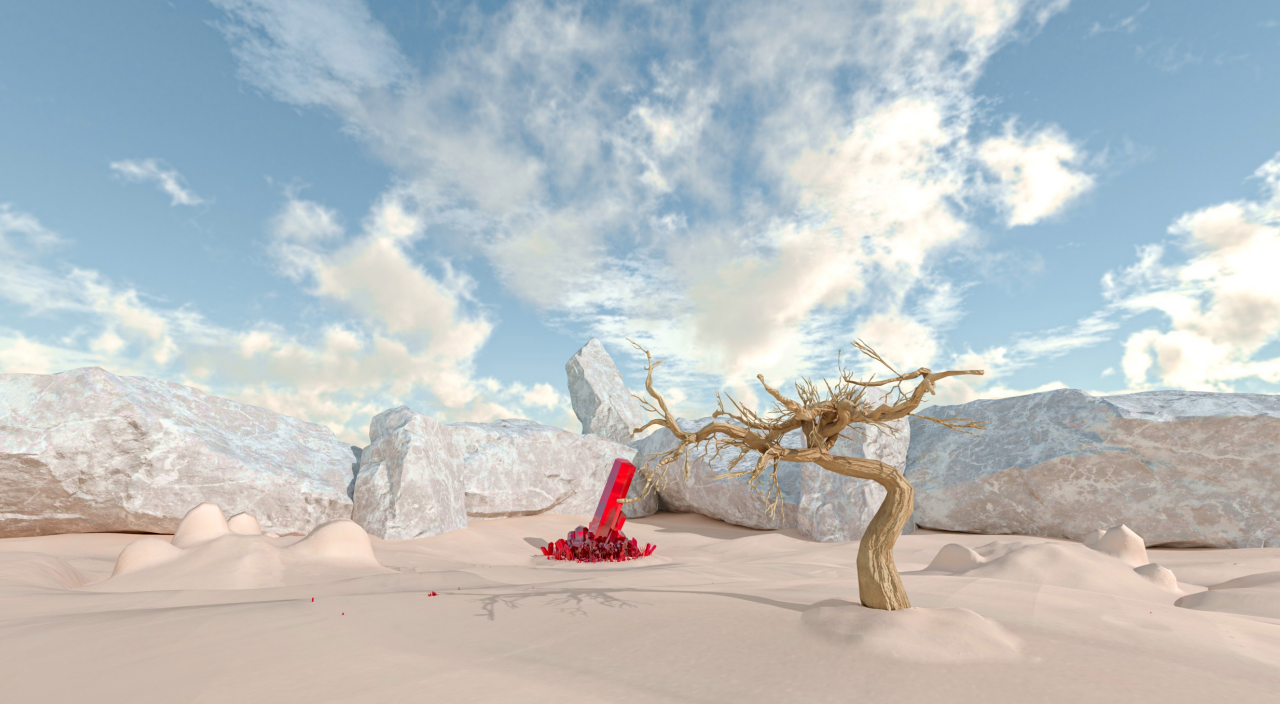
Lena Biresch - Me, Myself & My Avatars (or remapping the homunculus)
VR Experience
This virtual reality experience is about the so-called homunculus, a mapping of the movements and sensations experienced by the body located in the neocortex. This homunculus is highly extensible and changeable. For example, if a limb is injured or amputated, the corresponding regions in the homunculus shift to other parts of the body. Jaron Lanier et al. name this concept ``homuncular flexibility`` and as a prerequisite for being able to identify with an avatar's body in virtual reality at all. Research into homuncular flexibility combines findings from psychology, neuroscience, philosophy and computer science and posits that the homunculus can also adapt bodies that differ significantly from the typical human form. VR thus becomes a toolbox to explore and max out undreamt-of interaction possibilities between brain and body. These psychosomatic relationships are made tangible in this VR experience through implementation in the Unity game engine. Based on the research results of Lanier et al., three different playable non-human avatars were developed: one with additional limbs, one consisting of multiple bodies, and one used to control the entire environment.
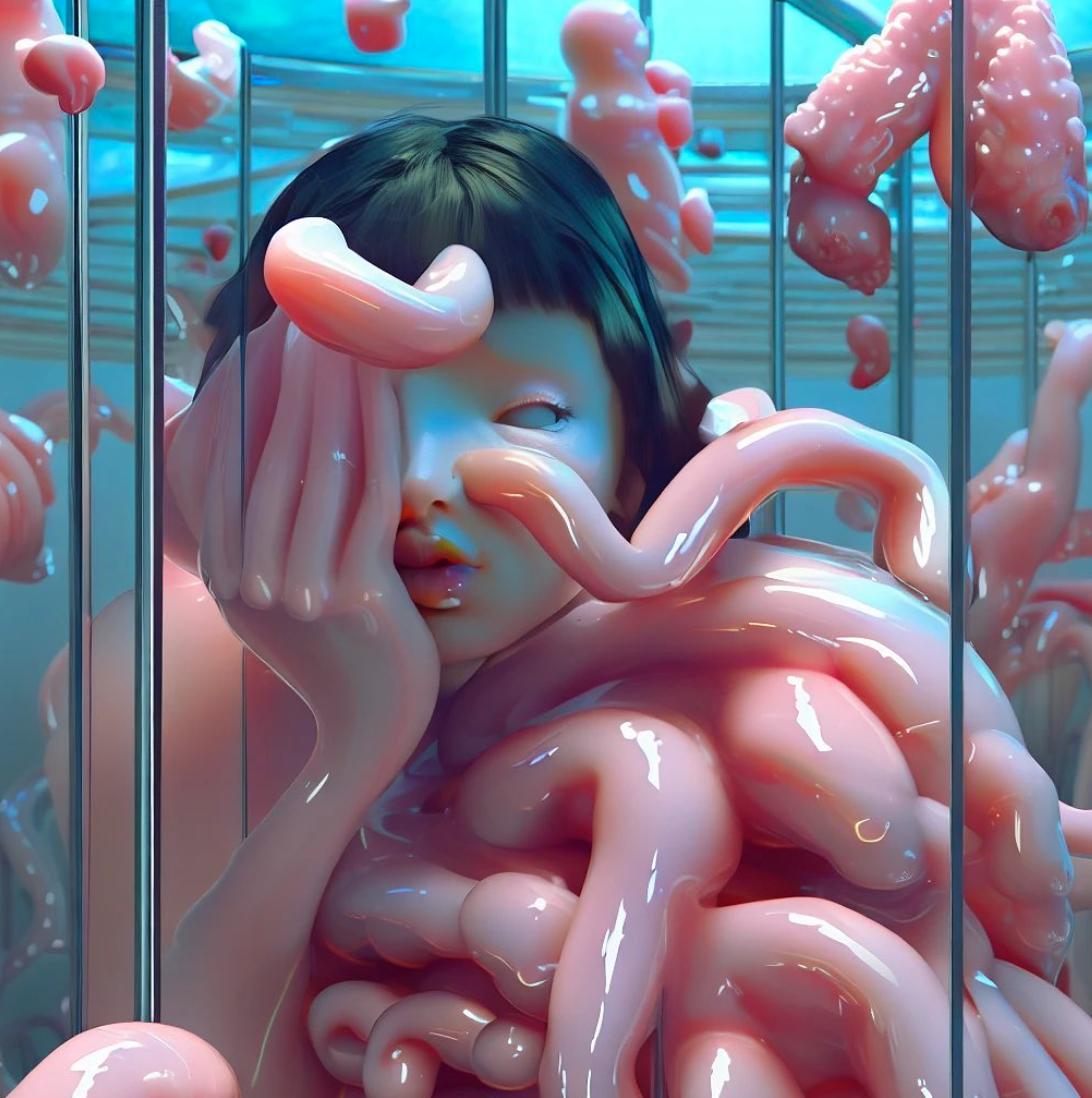
Dilara Baskoylu - Virtual Echoes
Digital Image Series
The series ``Virtual Echoes`` unfolds a narrative that dwells at the nexus of human experience and artificial creation. It is an exploration of transformation, where the boundaries between what is real and virtual are not just blurred but transcended, giving life to a new reality that challenges conventional perceptions. In this landscape, each image is a moment frozen in time, capturing the metamorphosis of form, color, and texture. The human and the machine, the physical and the digital, the concrete and the abstract—all intertwine in a dance that goes beyond dichotomies. It's a celebration of the harmonious balance between contrasting elements, where shapes and forms interact to reflect the multifaceted nature of existence. The journey through the series is a voyage into a world that reimagines the essence of becoming. It's an odyssey into a virtual existence where traditional concepts of identity are deconstructed and reconfigured. The images become portals into a philosophical contemplation of transformation, evolution, and the endless possibilities that lie beyond the realm of the known. The series ``Virtual Echoes`` delves into a reality where human essence and machine existence converge. The works explore a transformative process that transcends the conventional dichotomies of human and machine, creating a fluid space where boundaries meld and identities evolve. Each image in the series unfolds a chapter in a digital odyssey, chronicling a delicate dance between the tangible and the abstract. From awakening to connection, exploration, embrace, and transcendence, the series mirrors the lifecycle of becoming, where subjects undergo profound transformations. The visual landscapes reflect a complex interplay between technological entities, social constructs, abstract notions, and human emotions, weaving a fabric that resonates with our multifaceted existence. In ``Virtual Echoes`` the concept of becoming-machine is not a literal metamorphosis but a metaphysical journey. It's an exploration of potentialities and desires that break free from fixed identities. The images convey fluidity, where the borders between the physical and digital are in constant motion, creating new modes of existence.
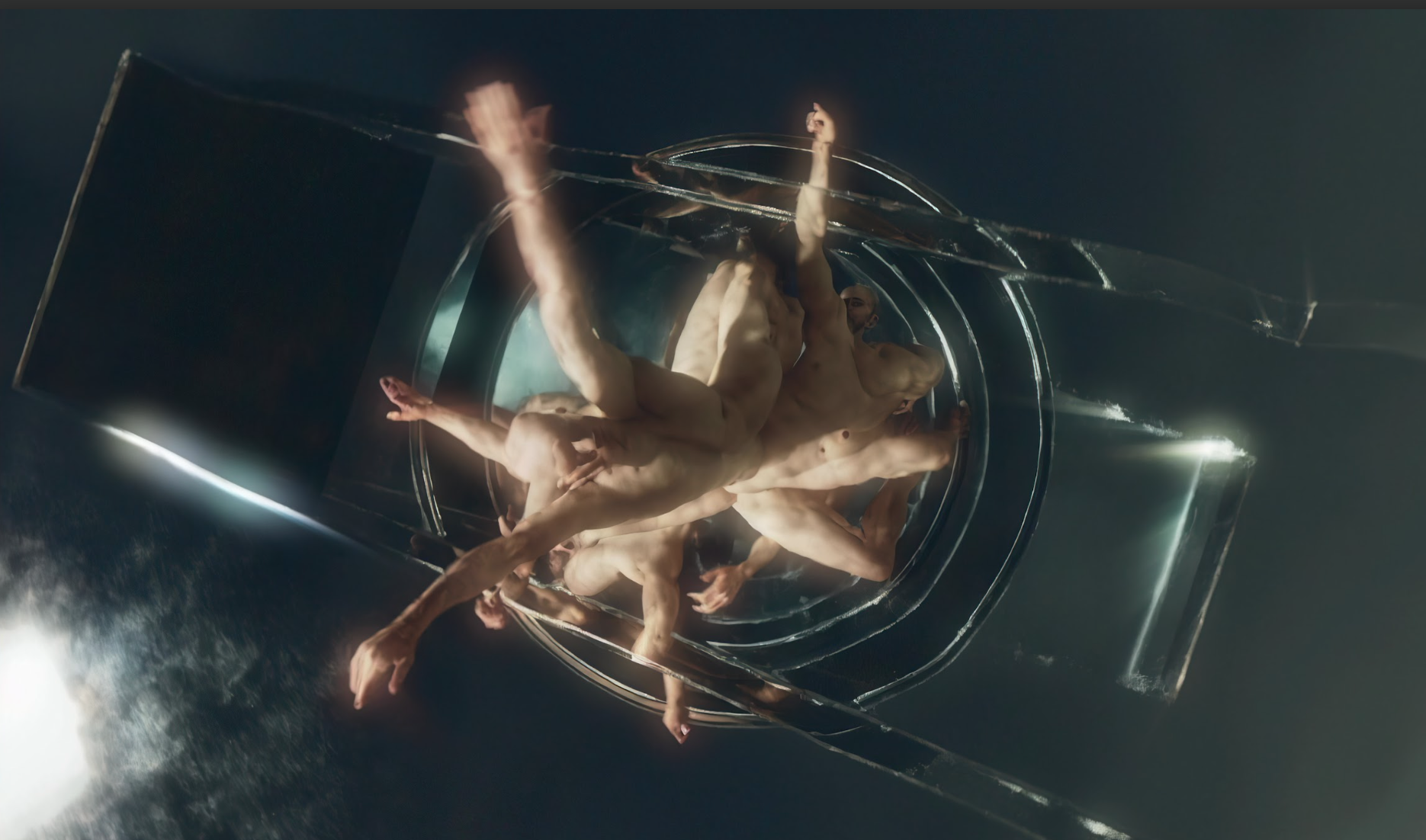
Maciej Szczygielski - Dissolution
Short Film
Dissolution is a short film exploring the idea of personal and collective transformation. The hypnotic and trance-like quality of the video, combined with the mutation and transformation of the artist’s digital avatar, reflects the disorientation and confusion that can occur when faced with profound change. The film, accompanied with recordings of the solar system’s planets and a human heartbeat, seeks to evoke a sense of both fear and awe at the possibility of hope in the unknown, bridging the gap between inner and outer space. It is a dream conjured by a machine mind that invites the viewer to contemplate the potential for growth and evolution in the face of adversity, embracing the strangeness of the inner human/machine-hybrid psyche.
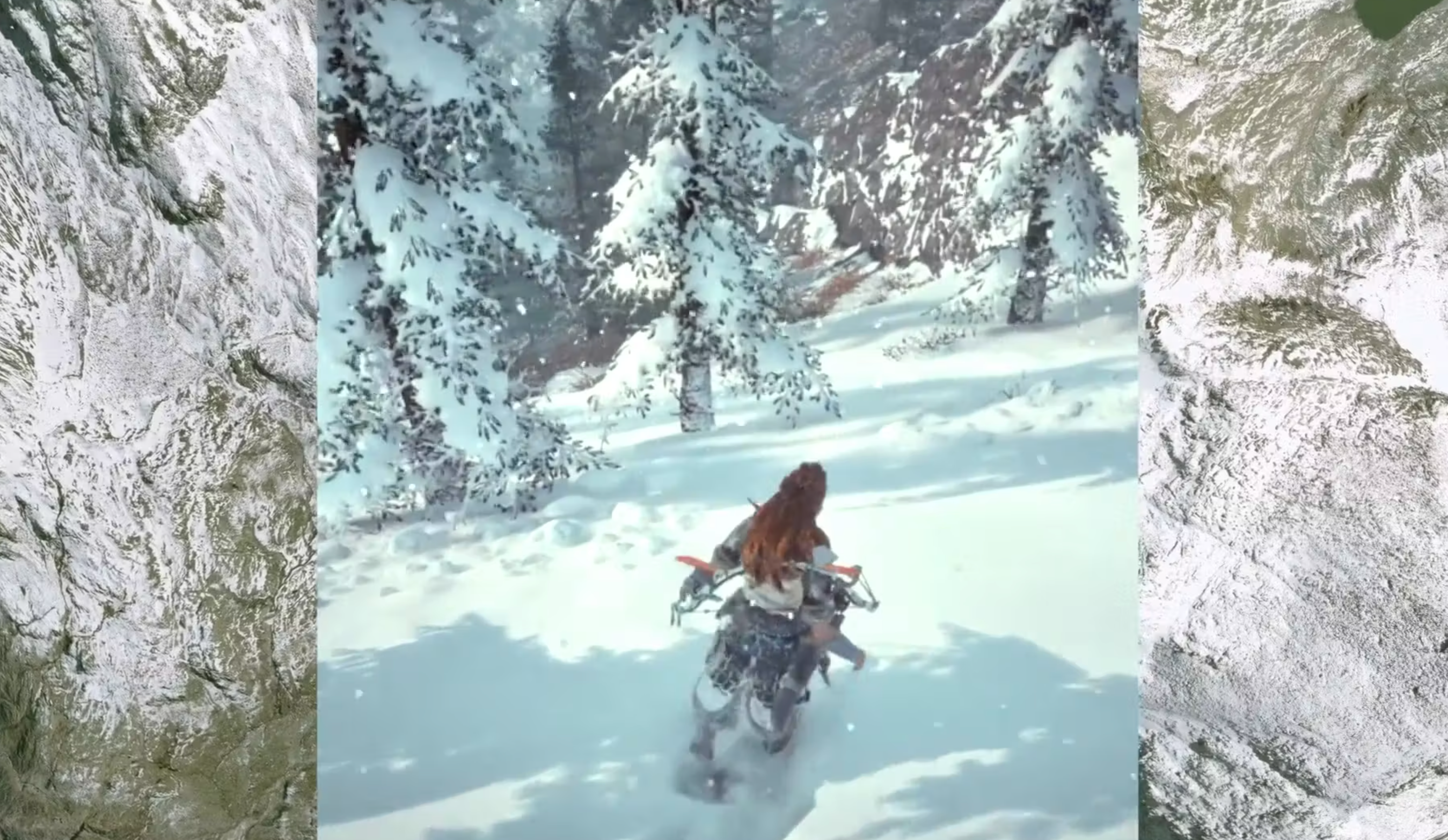
PolakVanBekkum - Walking the Machine
Machinima
‘Walking the Machine” was made as Machinima or Gameplay in the open-world video game 'Horizon Zero Dawn’, more specifically in the ``Frozen World”, a mountain-like area where the main character can leave footsteps in the snow. Our goal was to create a drawing with that possibility. ``A Line Made by Walking`` by Richard Long was an artistic reference for us. To make the walk leisurely, we had to spend some time gaming in the mountains to defeat enough opponents so that we had created a sufficiently peaceful terrain. Despite this, you can sometimes hear opponents' growling in the distance, but they do not appear close enough to disturb the hike or the footsteps. The sound in the work is the actual sound from the gameplay. In addition to the recordings in Horizon Zero Dawn, we made recordings in the mountains of Google Earth (with a coded track to match the walking speed in the gameplay - rendered with GE 'movie maker'). We intended to contrast the relationship between digital mountain landscapes in games and those made with satellite images - two fictions juxtaposed. visual artists, PolakVanBekkkum sound designers - actual Gameplay recording software: (gameplay recording options from) Horizon Zero Dawn, Google Earth (using kml coding), Adobe Premiere

Martina Menegon - I'm sorry I made you feel that way (memories of care)
Interactive Installation
“I'm sorry I made you feel that way (memories of care)” is an interactive experience and performative self-portrait exploring new possibilities for empathy and care for our hybrid selves. Martina Menegon’s biometric data collected daily via a wearable smart ring device is linked with an artificial avatar generated via Machine Learning AI. The physical body state - specifically in connection to stress and tiredness - has an immediate and direct impact on its virtual extension. When physical bodily needs are neglected and fatigue or stress sets in, the AI self-body deteriorates, exhibiting fragmented and abstract behaviour and making interactions increasingly challenging. In linking very personal biometric data to an AI generated avatar, “I'm sorry I made you feel that way (memories of care)” draws attention to our hybrid corporeality and how we can foster care both offline and, by extent, online. This intimate and intricate bond creates a new sense of responsibility for our virtual extensions and nurtures a unique emphasis on self-care that extends beyond our physicality. Accompanying the physical installation, “I’m sorry I made you feel that way (memories of care).extended” is an iteration of the interactive installation specifically created for digital, online and hybrid spaces. Screenshots taken from a live performance with the interactive installation are transformed, in collaboration with AI tools, into virtual sculptures with Augmented Reality capabilities.
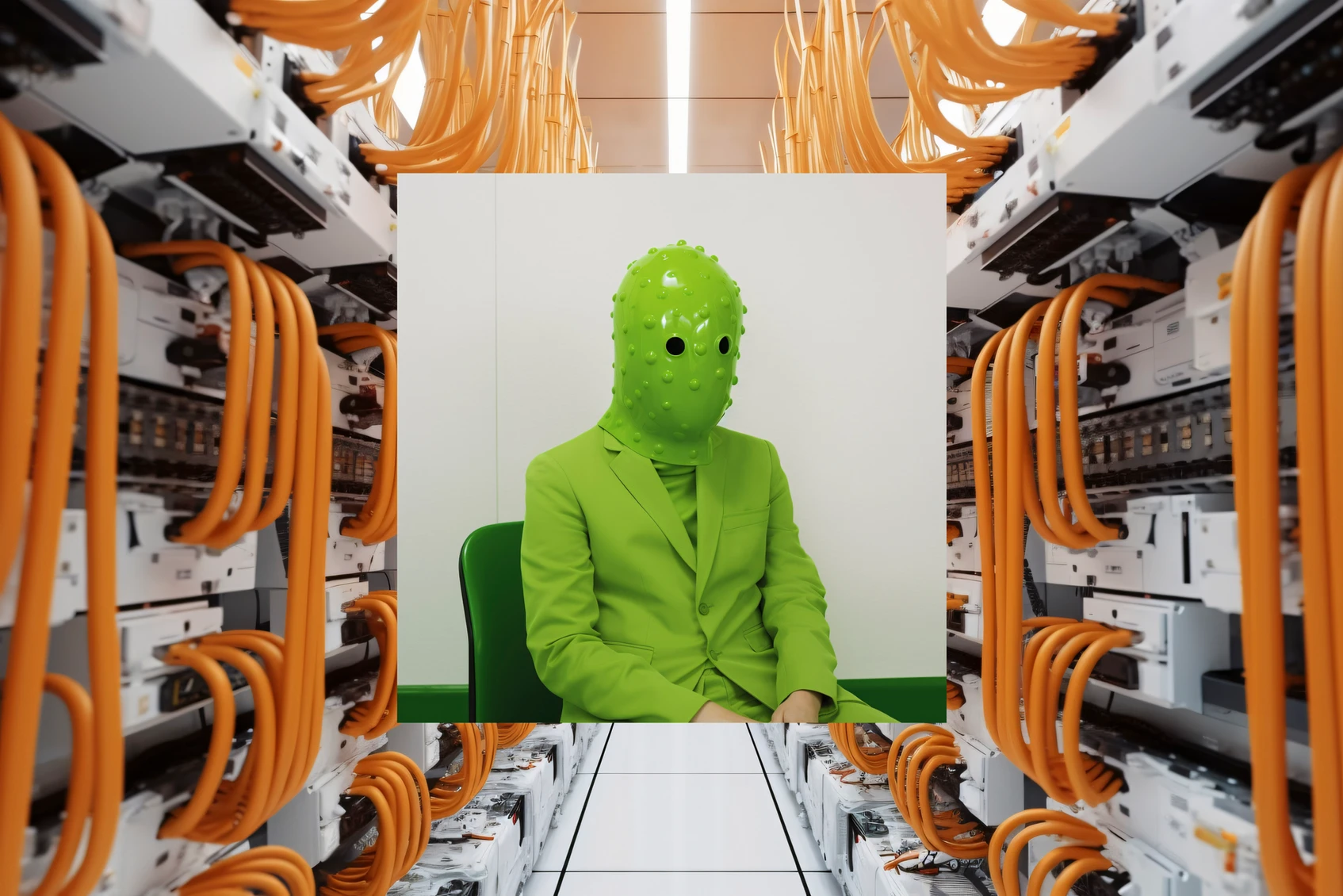
Jiayuan Yu - Ghost Work
Digital Image Series
Ghost Work refers to simple and repetitive online tasks assigned by algorithms to temporary workers to train machine learning. AI has created a new working class, but it exists almost as invisibly as ghosts. Anthropologist Mary L. Gray has proposed the Paradox of Automation's Last Mile. Underestimated temporary work is the key to driving technological innovation, but these marginalized labors are hidden in the capital hype. They are unprotected by law, even with a string of numbers replacing their identity in human society. These works are AI images. Image annotation is the main ghost work and the starting point for AI images. Generating images for ghost workers with models trained by themselves is like a Möbius circle, allowing the hidden parts to slowly emerge. The uniform is used to symbolize these people, rather than figurating their faces. The green suits look like movie green screen costumes, which digital software can readily identify and eliminate. The fictional work scenes, team photos, and even dense identity photos seem to satirize how marginalized and vulnerable people are treated in this age of consumerism.
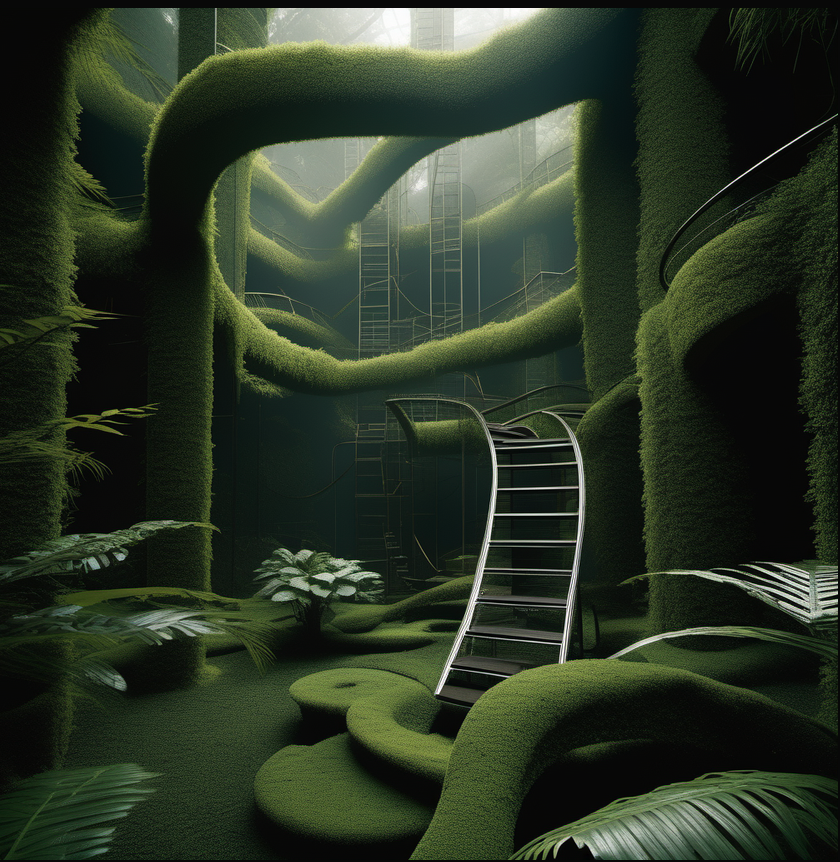
Amos I. - Latent Spaces
Digital Image Series
``Latent Spaces`` is an art collection inspired by Deleuze's philosophy of becoming human. Containing 20 unique pieces, each artwork delves into the concept of transformation and fluidity. Rooted in the five major biomes on Earth – Forest, Aquatic, Desert, Tundra, and Grasslands – the collection explores dream-like spaces that solely exist within the boundless dimension of the AIs latent space. Through a harmonious fusion of art and technology, ``Latent Spaces`` unveils a mesmerizing journey of ever-evolving forms, reflecting the intricate interplay between humanity and nature's diverse realms.

Liu Jiayu - Lakeside Echo
Motion Graphic
Starting from Bangalore, we aim to address the water and climate crisis on multiple levels, examining similar issues. Researchers have extensively studied the problem and potential solutions. However, the most formidable challenge lies in raising public awareness and motivation and integrating this knowledge into the minds of citizens. In this project, as part of our sustainable series, we have chosen the cave language to create a simulation system for water resources. By representing water molecules with particles, we visualize stories and factual data, employing art and technology to convey the concept of crisis and resonance. These visuals aim to imprint shocking facts into the audience's consciousness, awakening their memory and motivation. Within this system, blue particles symbolize the water molecules of the lake. We employ them to simulate the lake's shape, the flow of rivers, and water movement patterns. Simultaneously, they serve as indicators of water resource issues. Driven by gravity and data, the particles mimic the motion of water, determining its direction and speed. The number and color of particles continuously reflect the quantity and quality of water, evolving with changing data. The projection, screen, and dancer combination forms a three-dimensional system of ``Time, Space, and People.`` Through visual representation, we narrate the story of water, evoking a sense of awe and shock within individuals. Simultaneously, we emphasize that humanity is merely an element in the vast universe. In this artwork, the artist generates dynamic images using AI-generated content (AIGC) based on changes in freshwater resources in Bangalore from 2000 to 2022. These images are presented simultaneously at different levels. After sharing the artistic concept and visual presentation with artificial intelligence, it gave us the resonant name: ``Lakeside Echo,`` encompassing the interconnectedness between humans, Earth, nature, lakes, and rivers.

Deirdre Barrett - Death and the Raven
Animation
Death and the Raven is an animation based on a dream about a Bergman-style personification of death meeting with a black bird who is the epitome of grief who meet on a frozen arctic tundra. I first digitally painted one image of the characters titled “Sorrow Bird” and then fed that and text for modifications to make more stills that were ultimately combined with an animation algorithm for the Death and the Raven short film.

Deirdre Barrett - The Diving Bell
Animation
The Diving Bell is based on a dream of four unwilling explorers dropped into the ocean in a flimsy antique vessel to encounter denizens of the deep. The alien sea creatures were curious and possibly even friendly while the divers were miserable with the meeting. I first digitally painted one moment of the diving bell’s descent and then used text prompts and movement directions to a deep learning algorithm to generate the short film of the dream journey.

James Bloom - Gold
Dynamic Crypto Art Series
NFTs provide a decentralised platform for digital art to be bought and sold, tracking ownership through cryptographic tokens. The market for NFTs is also driving the hyper-financialisation of art, with digital art being bought and resold in a matter of seconds online. Digital art has become a financial asset and NFT collector behaviour resembles that of market speculators. Art has in some ways been subsumed by its market. GOLD is a dynamic crypto art series where the artworks change in response to the series’ own live NFT market activity. The actions of GOLD collectors become part of this ever-changing series of works, where prices, levels of activity and provenance define the imagery and composition at any moment. From an online sale to a listing, from the amount of time an artwork is held to whether it has recently been flipped, all this data is recorded by the NFT contract and reflected live in each GOLD piece. The artworks have conditions, for example only collectors who hold onto their pieces for long periods of time can claim ‘bonus’ visual elements for their artworks. The artworks are subsumed by their own market and the artist gives up some control over the work, but by doing so gets to define the context through which the market for their art is presented back to the viewer. Collectors’ actions in the market are tracked automatically by on-chain code and made visible. The abstract compositions can be read as a kind of ‘market structure’, with dominant and subordinate elements together. They can often look like landscapes or urban networks. Human elements appear in some pieces. The associations between the different image-symbols are fluid because the compositions are constantly changing according to the market, opening up new potential views. Are you looking at art or its market? GOLD is an artistic exploration of NFT market behaviour and the ways in which market networks influence our experience of art.

Seph Li - Your Story
Interactive Artwork
This interactive artwork utilises advanced machine learning technologies to bring real-life objects into virtual scenes with contextual awareness. Contraditory to traditonal AR artworks which virtual objects are overlayed onto camera feed, this artwork analyse real objects from camera feed and generate virtual stories with them. It discusses the existence of an object, when turning into pixels, does it still holds the same property as its physical mirror? In this machine-made reality, where everything is made up with pixels, what exactly does its meaning comes from?
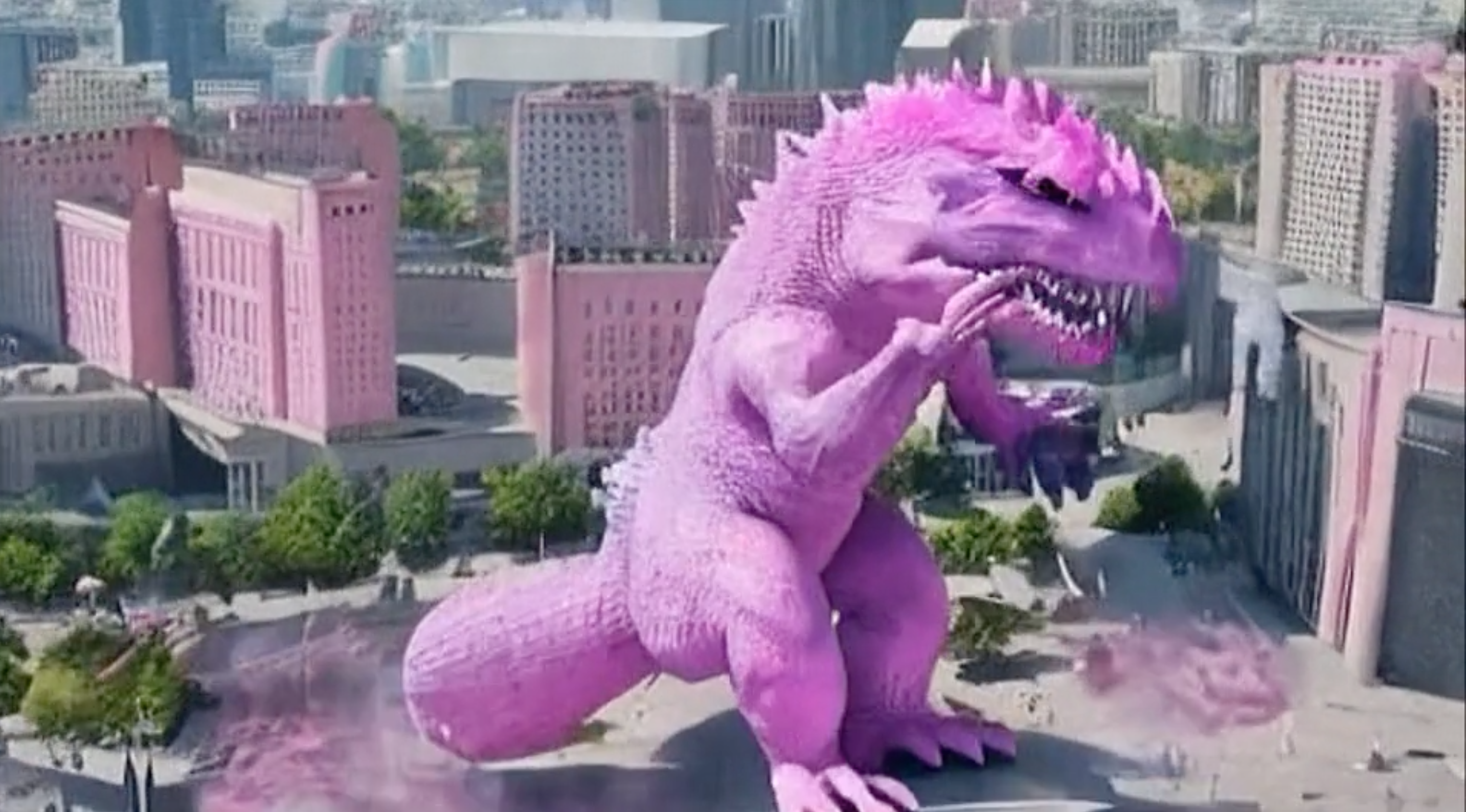
Christophe Bruchansky - AI Phantasmagoria
Digital Phantasmagoria
The work captures scenes of chaos as fires and riots engulf the city. Mysterious robots clash with colossal creatures, leaving everyone bewildered by the unexpected confrontation. This gripping scenario is purely a work of fantasy, a computer-generated phantasmagoria—an amalgamation of fantastic and bizarre imagery. The videos are generated by artificial intelligence, drawn from millions of online videos and pop culture references. AI is not a human artificial intelligence, but as societal artificial intelligence. Its imagination does not stem from a specific individual, but from all the data that society publishes on the Internet. Thus, AI does not imitate human thought, but rather captures the zeitgeist. It represents the next stage in our attempt to create a conscious entity called society; something that could carry our thoughts and outlive us. However, this process is not without risks. In contrast to what Deleuze suggests, the machine is not expanding our horizons, but rather recycling and reprocessing our subjectivities, thereby reinforcing our fears and prejudices. As artists, we should not allow the machine to take the lead, but rather enable it to break free from society’s norms and established categories. The machine should also become more human in this process.
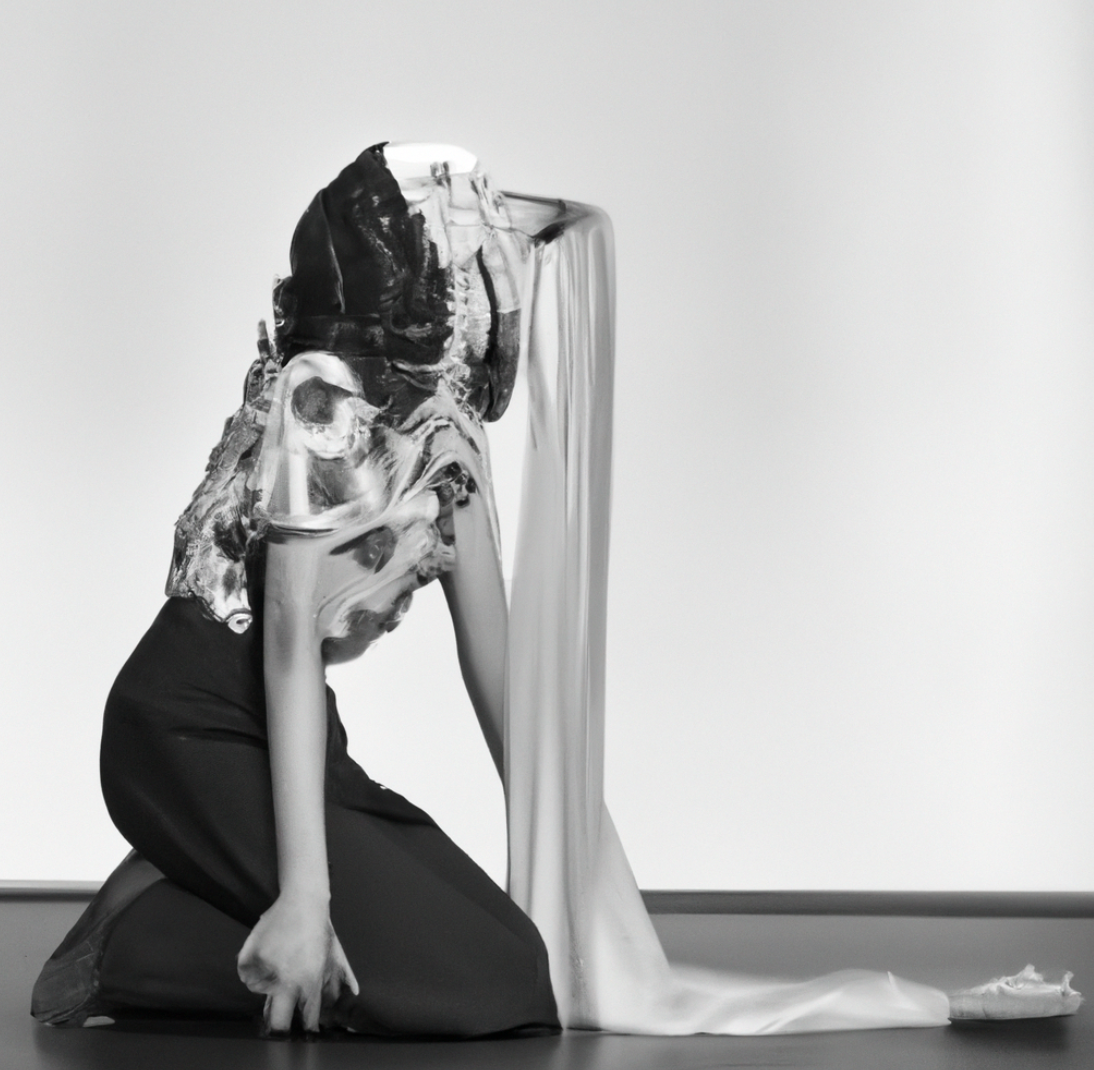
Liliana Zaharia - Human x AI
Digital Image Series
During my high school days, I began to have a dream where I would chew gum, but when I tried to spit it out, it would turn into a never-ending strip that I couldn't completely remove from my mouth. The dream would continue, and I would struggle to extract the gum until I woke up. I could never entirely remove it, and some bits would always get stuck to my teeth. Soon it became a recurring dream, sometimes repeating itself several times a week and other times several months apart. Later in my life, during therapy sessions, this dream became central to defining my traumatic childhood. It was interpreted in many different ways: an inability to express myself, repressed emotions, attempts to eliminate or fix relationships, anxiety, frustration, and even a far-fetched idea that my mind might have been signalling that I had scar tissue - because of the visual resemblance between scar tissue and chewing gum - within my body that would eventually cause life-changing surgery years later. Regardless of the reason for the dream, what persists is the feeling I have: a sort of muted nightmare, where there is no fear or anxiety but rather an eternal punishment which I diligently try to finish, stuck into a Sisyphus scenario. What draws me into thinking about it, is the quality of our unconscious to gather past experiences, memories, and emotions, and to use this information to create new symbols. Similarly, I have been intrigued by the new AI technology, and in particular imagery creation algorithms, that can draw upon vast amounts of data to create new imagery. The analogy between the process of AI and human dreaming has pulled me into using the new technology and creating a visual representation of my dream. The process was a complete departure from my usual photographic approach. While I might plan what I want to capture in a photograph, there is also an intuitive process where I have to see, observe, look, capture, and frame. Possibly an unconscious choice between one moment and another is also part of it. However, working with AI technology, I had to start with a text description such as ``a kneeling woman pulling infinite chewing gum out of her mouth,`` which serves as the visual concept or idea to be translated into an image. DALL-E then utilises its deep neural network architecture, trained on a massive dataset of diverse images, to generate a corresponding visual representation. Instead of constructing an image or capturing a moment, I had to find a visual language that the AI would interpret into what I wanted to see. The AI model goes through a series of iterations and refinements to produce an image that closely aligns with the provided textual description. It analyses patterns, shapes, and contextual cues from the text, and combines them with its understanding of various visual elements acquired from the dataset. What grabbed my attention was an image where the imperfections of AI imagery were visible: an amalgamation of skewed elements that overall resembled my description but was not a perfect copy of reality. The type of imagery that you know it’s created digitally, but which was closer to translating the feeling of the dream: stuck and embedded, struggling, confused, disturbed, scrambled between symbols that the AI put together. I would say, not very different from what my brain does during the night, feeding me back mixed imagery from all the experiences I have had. The chewing gum became part of the body and the body became an amalgam of chewy, sticky pieces: the never-ending struggle melting into a disturbing coexistence of elements. The body becoming the chewing gum itself. The imagery already comes with a title: Human x AI (Liliana x Dall-E). A sort of collaboration between myself and the AI; a co-creation. Nonetheless, the collaboration extends to millions of other people that have created the imagery that was fed into the AI, and from which the imagery has been pieced together. A collective portrayal and interpretation of my dream.

Frida Braide - Me, Walking
Mixed Media
Firstly, Me, Walking is a collaboration with google maps timeline and an iphone8 over the period when I moved to New York City and my first couple of months living in the city. By letting google maps record my movements during this time, from the 26th of February to 8th of April 2022, I am creating visual diagrams over how I moved in this space. Secondly; the project is a mentality study. Those days where I didn’t walk at all, being isolated in my apartment, is left as black squares; empty. The study also clearly indicates the same movements being done over and over again, setting a new routine in a new city. The idea is to capture the change and development from being a newcomer to starting to feel a sense of belong in a new space. I walk, the machine records, and left is visual digital sketches over human movements.
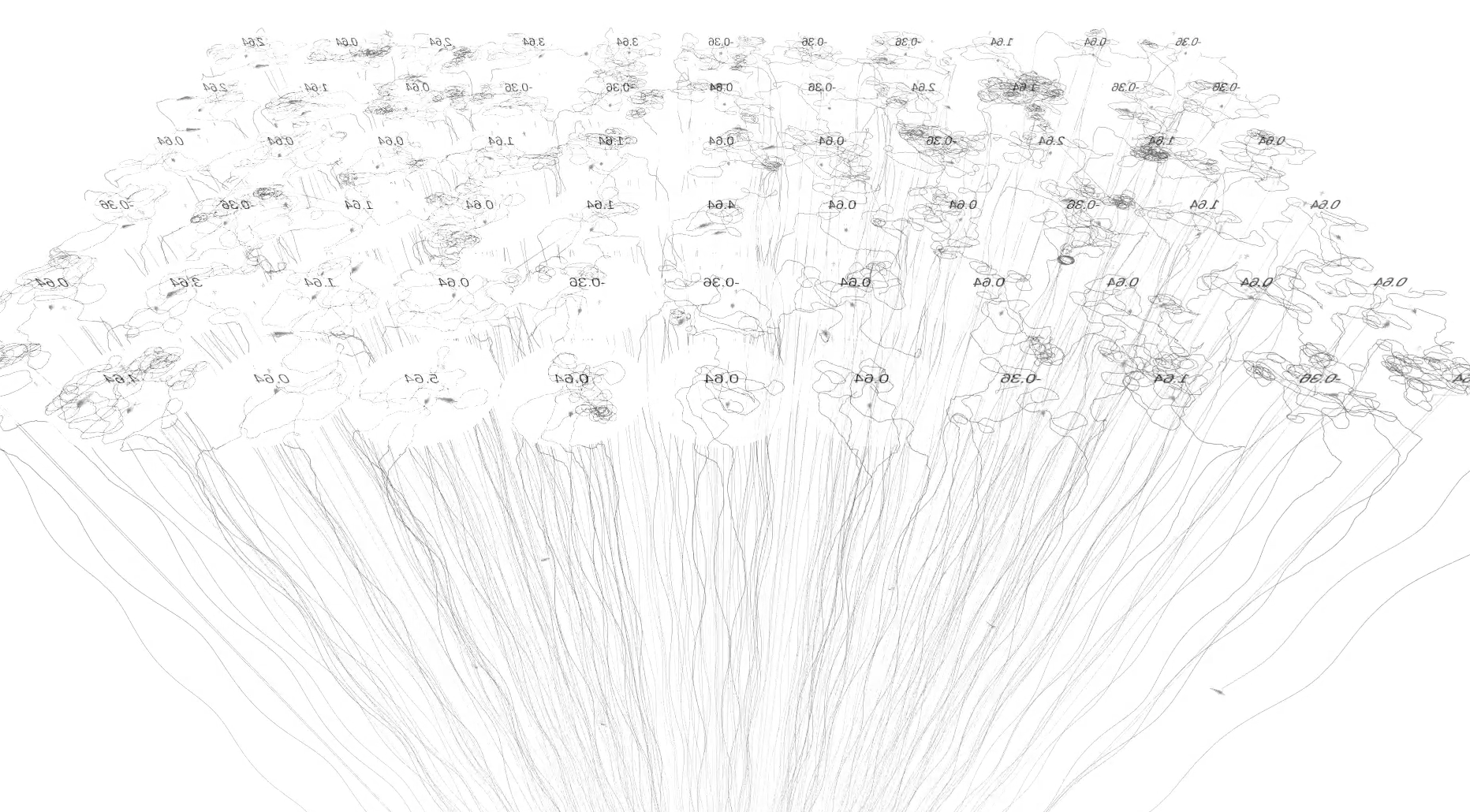
Hana Yoo - The Fall
Machine Learning Generated Moving Image
“Is outside of the chamber, a failure, escape, death, or rebellion?” An algorithm trained the falling rats in the video for 23 seconds to perform a specific task in a specific area. As a result, most rats failed (did not perform) the task and fell out (escaped) from the chambers. After a certain period of time, the rats were summoned back to the original area and the process was repeated for as long as the program ran. The black lines in the graphic were generated by the movement of the algorithm’s agent (rat) and show the behavior patterns.>> In 1948, a psychologist B.F. Skinner devised an operant conditioning chamber (known as a ‘Skinner box’) to study animal behavior. Using a lever system that a rat presses to gain food inside a chamber, Skinner discovered that the food acts as a ‘reinforcement’ that induces the rat’s repetitive behavior. The premise that responses through conditioning shape actions became a pivotal model of Behavioral psychology, and Behaviorists consequently conducted various animal experiments to examine deeper on the learning process and problem-solving of the organism. Today, Machine Learning (ML) offers a complex learning model—reminiscent of Skinner's principles—particularly Reinforcement Learning (RL), which concerns how the agent takes action in an interactive environment in order to maximize reward. This mirrors aspects of human and animal training, despite differing purposes and contexts. Having concerned the outcome of training deeply intertwined with human behavior and the economics of ecology, the questions arise: Are the anthropomorphized expressions toward nonhumans such as ‘machine, animal learning’, and ‘machine intelligence’ part of ‘becoming’? Is there a new type of empathy emerging through the technical apparatus? What makes the animals in the lab invisible, and their labor unrecognized? In the generated moving image ‘The Fall’, the 3D-game-object-rats were trained for 23 seconds to perform a specific task in a specific area by the machine learning algorithm. As a result, most rats failed (did not perform) the task and fell out (escaped) from the 66 chambers. After a certain period of time, the rats were summoned back to the original area and the process was repeated for as long as the program ran. The black lines in the graphic were generated by the movement of the algorithm’s agent (rat) which indicates their behavioral patterns, and the omnipotent perspective rotates around them.
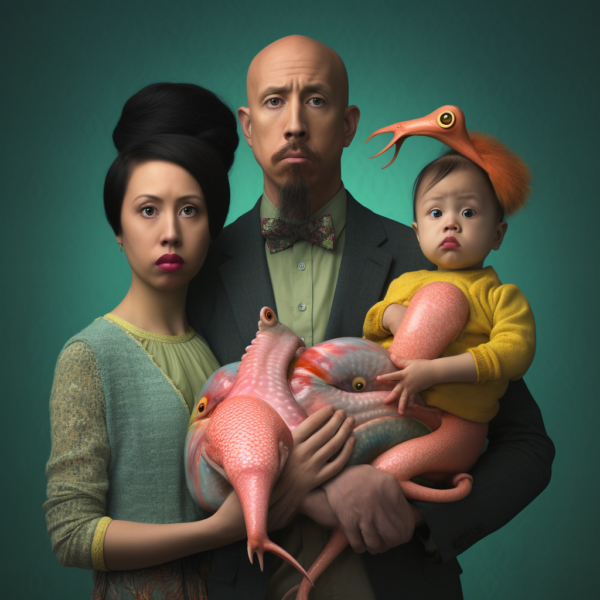
Joe Meiser - Viridian Fractal Chiaroscuro
Digital Image
This image is from ``Viridian Fractal Chiaroscuro``, a series of digital prints that were created in dialogue with artificial intelligence (AI) to explore the complexities of our ever-deepening relationship with technology. In keeping with the concept of the “Becoming-Machine” exhibition, this project examines the potentially disruptive possibilities that may result from our use of machines of all kinds, including technological devices, algorithms, social constructs, etc. ``Viridian Fractal Chiaroscuro`` questions the way our human form and identity could change as we alter ourselves biologically (via pharmaceuticals and direct modifications to our DNA), and as we continue to integrate synthetic elements into our bodies. This project also considers the societal implications of the ongoing digital metamorphosis. For example, how will our relationships evolve as new technologies redefine our socioeconomic landscape? Will the future hold a utopia birthed from technological progress, or a dystopia where humans lose control? How might the fabric of society be reshaped when AI surpasses human intelligence?
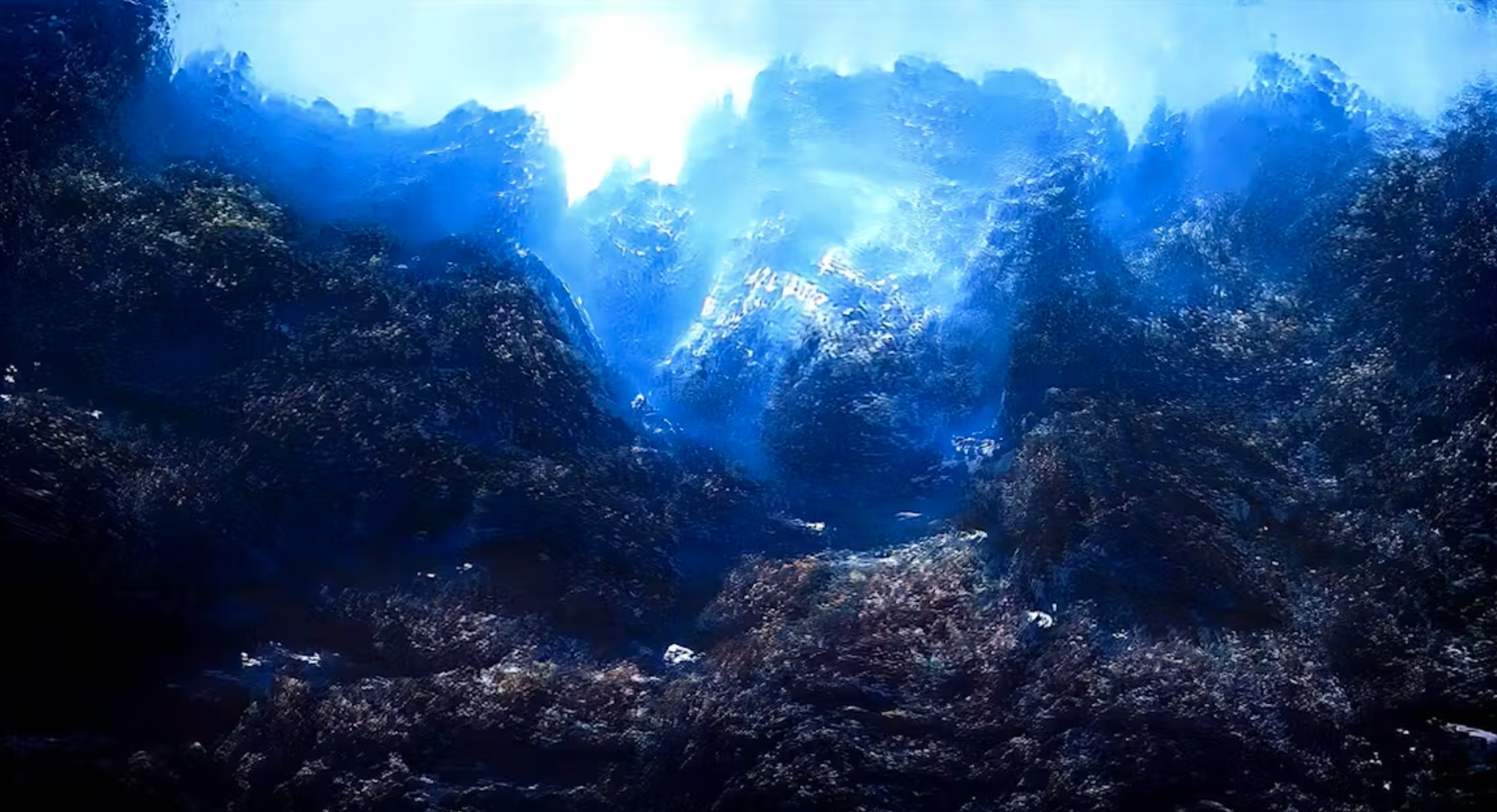
Karlos Gil - Deep Image
Immersive Video Installation
DEEP IMAGE consists of an immersive video installation that, through collaboration with a programmer and a neuroscientist, will decode the activity of the human brain in sequences of images. Through an artificial intelligence 'software' developed in collaboration with the Kamitani Lab of the University of Kyoto and the Laboratory of Cognitive and Computational Neuroscience of the Polytechnic University of Madrid, an immense and complete conceptual map of brain images obtained from the memories, dreams or sounds of a group of people. Artificial intelligence will use convolutional neural networks -better known as 'deep learning' networks- and will be made up of internal layers of 'software' that will share information with each other to produce synthetic forms from the data obtained. `{`technical explanation`}` The main idea of TIMEFALL is to reconstruct the images, thoughts and memories that are formed in the brain by a deep neural network, which visualizes the information from magnetoencephalography analysis (MEG) in a video installation. In order to do this, I collaborated with one of the leading laboratories in Europe, the Laboratory of Cognitive and Computational Neuroscience of the UCM University from Madrid and the the Kamitani Lab of the University of Kyoto, using magnetoencephalography techniques (MEG) to obtain all this information from 50 people.

Seph Li - Phase
Interactive Installation
This interactive installation uses data and unites the rules of Wolfram’s physics with Chinese Taoism, applying scientific hypotheses to a generative visual system. Images are projected onto frosted glass, and visitors use controls to trigger and manipulate animations that inject energy into the system of the universes. The theory depicts the reality as a generative entity where the time-space follows pre-coded rules, and by witnessing these simple rules growing into complex structures it unveils a possible machinary truth of our own universe.

Allie Dechow - The Sum Total
Visual Poetry
In The Sum Total, we plunge into the story of two transdimensional forces describing their lived experiences across different yet interwoven spatio-temporal worlds. This alludes to fictive as well as real historical sites fluidly intersecting: framed as a chimeric tale of imaginary possibilities, we elude conventional notions of our perceived reality of time, space, and existence on earth. The tale asks the viewer to redefine their perceptions of our subjective realities, and explore the possibilities of realms where things that were thought of as incompatible and separate may coexist and meet with blurred boundaries.

Ali Nazim Besikci - Becoming Urban Machine
Animation
Major catastrophic events have many effects on society in various levels and categories, as is the pandemic, we all experienced. Lack of socialization was one of the major impacts of the recent pandemic that we’ve dealt with digital technologies. Since civilization is one of the most valuable part of having a sentient life on earth, it cannot be imagined without socialization. According to Deleuzian theory, territorialization has to be occurred for social machines to work. This territory for an urbanite is obviously the urban ground where social machines generate cultural forms by society’s technical machines. Becoming Urban Machine is the visual appropriation of these occurrences that the urbanite became the machine itself. The use of artificial intelligence (ai) in this work, makes emphasis on its automated nature of urbanite’s routine both in the visuals and in the audio. The initial source of ai generated visuals is a digital painting that depicts a cybernetic white collar employee which is puts another emphasis layer by criticizing the robotic life practice. On the other hand the layers of music assembles all the visual layers to become an ever-changing machine that creates the urban without routes.

Stephen Roddy - Opening to the Ambient Light
Stochastic Composition
Opening to the Ambient Light is a stochastic composition expressed in an ambient style through generative means. It is informed in its structural realization by Xenakis' stochastic work while its aesthetic aspect is realized in reference to Milton's Paradise Lost. Gordon Pask's cybernetic conversation theory provided a conceptual apparatus to approach Deleuze’s becoming-machine, that mode of existence in which the border between the human and machinic becomes less a force of division and more of a method of integration through deterritorialization. Sonically the piece conjures something of the interplay of light and darkness that continually recurs across Milton's epic poem Paradise Lost. This is recontextualized in terms of man and machine as generative audiovisual techniques render the struggle between chaos and cosmos as randomly generated parameters that become intelligible compositional choices thanks to a series of self-correcting feedback loops at the micro, meso, and macro levels of the stochastically driven generative music system underlying the piece. The sonic and visual result is a conversation in which the light and dark become immanent for the listener through their dialog with one another. Man and machine cease to be at odds here and rather a third thing, Deleuze’s becoming-machine is set in process. This process in turn announces itself both visually and sonically As the fixed identity of the human as composer/artist and machine as tool is challenged in this piece as the machine makes compositional choices from within a possibility space defined in collaboration with the human, but not entirely by the human. The fixed identity of the composer and the visual artist are disregarded here as a process of transformation, disrupts established musical and visual categories opening up a space for new creative possibilities. In this way, the conversation itself between sound & space, light & dark machine & human, operating as becoming-machine, thus producing the work.
Join capitArt Discord Community & Becoming Machine Exhibition channel to discuss the future of art, and the exhibition content, share your artworks and follow our upcoming program and events.
Our discord community focuses on digital art and especially AI art. Feel free to enter into a dialogue with the impact of technology on your artistic practices and daily life.
Join with the link: https://discord.gg/Y8uzMppdVs

